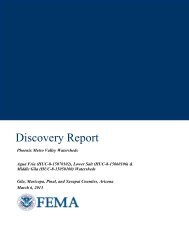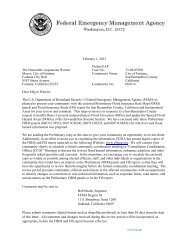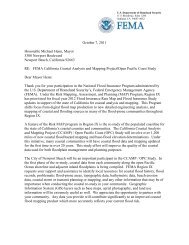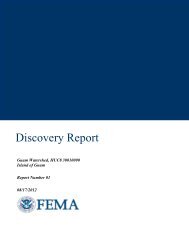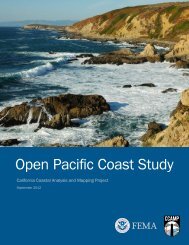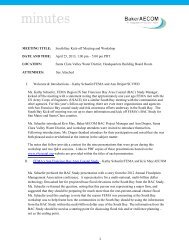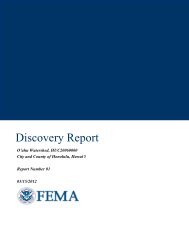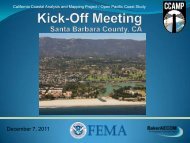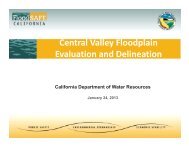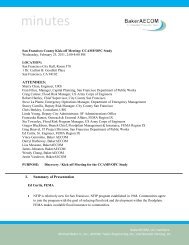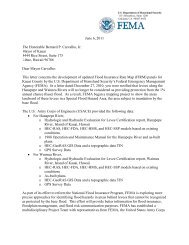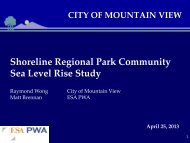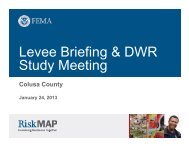YAVAPAI COUNTY, ARIZONA Federal Emergency ... - FEMA Region 9
YAVAPAI COUNTY, ARIZONA Federal Emergency ... - FEMA Region 9
YAVAPAI COUNTY, ARIZONA Federal Emergency ... - FEMA Region 9
You also want an ePaper? Increase the reach of your titles
YUMPU automatically turns print PDFs into web optimized ePapers that Google loves.
All flooding sources were analyzed to determine the peak discharge for the 24-<br />
hour rainfall distributions.<br />
The Town of Wickenburg, Maricopa County, requested a restudy for Sols Wash<br />
based upon studies performed by the NRCS and PRC Toups Engineering (PRC)<br />
(PRC Toups, 1981). These studies yielded peak discharges significantly less than<br />
what had been assumed in the previous analysis for the effective Flood Insurance<br />
Study for the Town of Wickenburg.<br />
The NRCS computer model TR-20 was selected for use in estimating the 10-, 2-,<br />
1-, and 0.2-percent annual chance peak discharges for various concentration<br />
points along Sols Wash. The TR-20 model utilizes the method of analysis<br />
described in detail in the NRCS National Engineering Handbook, Section 4,<br />
Hydrology, 1972 (U.S. Department of Agriculture, 1972). This method allows for<br />
the prediction of surface water runoff for an individual watershed using rainfall<br />
duration and intensity data. The TR-20 model provides a convenient means of<br />
predicting the results of storm runoff from multiple watersheds. The storm runoff<br />
for individual watersheds is computed and an outflow hydrograph simulated.<br />
Individual hydrographs may then be routed and combined to obtain the<br />
cumulative downstream effects.<br />
The precipitation frequencies for the area were obtained from isopluvial maps<br />
prepared by the U.S. Weather Bureau. The NRCS Type II rainfall distribution was<br />
used to model the rainfall, which was adjusted using an areal reduction based<br />
upon the total drainage area. Such reduction is necessary to convert from the point<br />
areal rainfall amount. Using soils maps of the area prepared by the NRCS, as well<br />
as site investigations, runoff curve numbers were selected, based upon<br />
information developed by the NRCS. Times of concentrations for steep and<br />
incised washes were computed using the Kirpich equation. For gently sloping<br />
alluvial plains, many of which occur on the upper northwest portion of the<br />
drainage basin, travel velocities were estimated assuming broad sheetflow and<br />
utilizing Manning's equation.<br />
Because there is no gaging station on Sols Wash, and thus no accurate record of<br />
historic flooding, there is no means to provide calibration of the rainfall-runoff<br />
model, and therefore only comparison with earlier studies can be made.<br />
The discharge estimates obtained from the TR-20 analysis for the study<br />
correspond with the results of both the NRCS and PRC analyses. The dischargefrequency<br />
curve developed by the USACE for the 1977 FIS has a steeper slope<br />
and results in a much larger 1-percent annual chance peak discharge than in the<br />
other studies.<br />
The NRCS, PRC, and Cella, Barr, Evans & Associates each employed the TR-20<br />
model in their studies, which might explain, in part, the consistency of the results,<br />
although the model is quite sensitive to changes in time of concentration, and each<br />
model employed different input parameters.<br />
22




